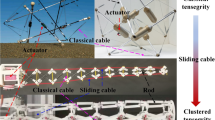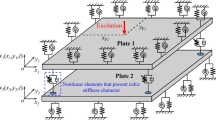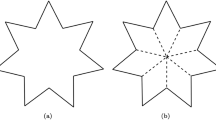Abstract
Rotation-free shell formulation is a simple and effective method to model a shell with large deformation. Moreover, it can be compatible with the existing theories of finite element method. However, a rotation-free shell is seldom employed in multibody systems. Using a derivative of rigid body motion, an efficient nonlinear shell model is proposed based on the rotation-free shell element and corotational frame. The bending and membrane strains of the shell have been simplified by isolating deformational displacements from the detailed description of rigid body motion. The consistent stiffness matrix can be obtained easily in this form of shell model. To model the multibody system consisting of the presented shells, joint kinematic constraints including translational and rotational constraints are deduced in the context of geometric nonlinear rotation-free element. A simple node-to-surface contact discretization and penalty method are adopted for contacts between shells. A series of analyses for multibody system dynamics are presented to validate the proposed formulation. Furthermore, the deployment of a large scaled solar array is presented to verify the comprehensive performance of the nonlinear shell model.


















Similar content being viewed by others
References
Bauchau, O.A., Choi, Y., Bottasso, C.L.: On the modeling of shells in multibody dynamics. Multibody Syst. Dyn. 8, 459–489 (2002)
Pappalardo, C.M., Wallin, M., Shabana, A.A.: A new ANCF/CRBF fully parameterized plate finite element. J. Comput. Nonlinear Dyn. 12(3), 031008 (2016)
Ren, H.: A simple absolute nodal coordinate formulation for thin beams with large deformations and large rotations. J. Comput. Nonlinear Dyn. 10(6), 061005 (2015)
Pavan, G.S., Nanjunda Rao, K.S.: Bending analysis of laminated composite plates using isogeometric collocation method. Compos. Struct. 176, 715–728 (2017)
Liu, Z.Y., Liu, J.Y.: Experimental validation of rigid-flexible coupling dynamic formulation for hub-beam system. Multibody Syst. Dyn. 40(3), 303–326 (2017)
Wempner, G.: Finite elements, finite rotations and small strains of flexible shells. Int. J. Solids Struct. 5(15), 117–153 (1969)
Belytschko, T., Schwer, L., Klein, M.J.: Large displacement, transient analysis of space frames. Int. J. Numer. Methods Eng. 1, 65–84 (1977)
Rankin, C.C., Brogan, F.A.: An element independent corotational procedure for the treatment of large rotations. J. Press. Vessel Technol. 108, 165–174 (1986)
Chimakurthi, S.K., Cesnik, C.E.S., Stanford, B.K.: Flapping-wing structural dynamics formulation based on a corotational shell finite element. AIAA J. 49(1), 128–142 (2011)
Cho, H., Shin, S.J., Yoh, J.J.: Geometrically nonlinear quadratic solid/solid-shell element based on consistent corotational approach for structural analysis under prescribed motion. Int. J. Numer. Methods Eng. 112(5), 434–458 (2017)
Faroughi, S., Eriksson, A.: Co-rotational formulation for dynamic analysis of space membranes based on triangular elements. Int. J. Mech. Mater. Des. 13(2), 229–241 (2017)
Sabourin, F., Brunet, M.: Detailed formulation of the rotation-free triangular element S3 for general purpose shell analysis. Eng. Comput. 23(5), 469–502 (2006)
Guo, Y.Q., Gati, W., Naceur, H., et al.: An efficient DKT rotation free shell element for springback simulation in sheet metal forming. Compos. Struct. 80, 2299–2312 (2002)
Oñate, E., Cervera, M.: Derivation of thin plate bending elements with one degree of freedom per node: a simple three node triangle. Eng. Comput. 10(6), 543–561 (1993)
Flores, F.G., Oñate, E.: Wrinkling and folding analysis of elastic membranes using an enhanced rotation-free thin shell triangular element. Finite Elem. Anal. Des. 47(9), 982–990 (2011)
Phaal, R., Calladine, C.R.: Simple class of finite elements for plate and shell problems. II: an element for thin shells, with only translational degrees of freedom. Int. J. Numer. Methods Eng. 35(5), 979–996 (1992)
Zhou, Y.X., Sze, K.Y.: A geometric nonlinear rotation-free triangle and its application to drape simulation. Int. J. Numer. Methods Eng. 89, 509–536 (2011)
Das, M., Barut, A., Madenci, E.: Analysis of multibody systems experiencing large elastic deformations. Multibody Syst. Dyn. 23(1), 1–31 (2009)
Liu, C., Tian, Q., Hu, H.Y.: Dynamics of a large scale rigid-flexible multibody system composed of composite laminated plates. Multibody Syst. Dyn. 26(3), 283–305 (2011)
Nour-Omid, B., Rankin, C.C.: Finite rotation analysis and consistent linearization using projectors. Comput. Methods Appl. Mech. Eng. 93(3), 353–384 (1991)
Battini, J.: A modified corotational framework for triangular shell elements. Comput. Methods Appl. Mech. Eng. 196(13–16), 1905–1914 (2007)
Shabana, A.A.: Dynamics of Multibody Systems, 3rd edn. Cambridge University Press, Cambridge (2005)
Felippa, C.A., Haugen, B.: A unified formulation of small-strain corotational finite elements: I. Theory. Comput. Methods Appl. Mech. Eng. 194(21–24), 2285–2335 (2005)
Wriggers, P.: Computational Contact Mechanics. Springer, Berlin, Heidelberg (2006)
Liu, C., Tian, Q., Hu, H.Y.: New spatial curved beam and cylindrical shell elements of gradient-deficient Absolute Nodal Coordinate Formulation. Nonlinear Dyn. 70(3), 1903–1918 (2012)
Xie, Q., Sze, K.Y., Zhou, Y.X.: Drape simulation using solid-shell elements and adaptive mesh subdivision. Finite Elem. Anal. Des. 106, 85–102 (2015)
Acknowledgements
This research was supported by the National Natural Science Foundation of China (Grants 11772188, 11132007).
Author information
Authors and Affiliations
Corresponding author
Rights and permissions
About this article
Cite this article
Shi, J., Liu, Z. & Hong, J. Multibody dynamic analysis using a rotation-free shell element with corotational frame. Acta Mech. Sin. 34, 769–780 (2018). https://doi.org/10.1007/s10409-018-0763-2
Received:
Revised:
Accepted:
Published:
Issue Date:
DOI: https://doi.org/10.1007/s10409-018-0763-2




